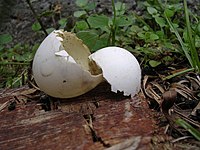
Photo from wikipedia
Abstract Metal-organic framework (MOFs)-derived Ni@carbon composites with three-dimensional (3D) yolk shell-like structure have been successfully synthesized by a self-template strategy. After continuous carbonization treatment, the metallic Ni was uniformly embedded… Click to show full abstract
Abstract Metal-organic framework (MOFs)-derived Ni@carbon composites with three-dimensional (3D) yolk shell-like structure have been successfully synthesized by a self-template strategy. After continuous carbonization treatment, the metallic Ni was uniformly embedded in the carbon matrix that could effectively protect Ni from corrosion and subsequent leaching. Carbon layers in Ni@carbon composites mainly existed in the form of graphene structure according to high-resolution transmission electron microscopy and powder X-ray diffraction pattern. As-prepared materials inherited superior properties of Ni-MOFs, such as large specific surface area, layered 3D yolk shell-like structure and abundant Ni content. As a consequence, among all synthetic materials, the Ni@carbon450 exhibited the most excellent catalytic activity towards Cr(VI) reduction in the presence of HCOOH. Impressively, highly toxic Cr(VI) in aqueous solution can be completely reduced to hypotoxic Cr(III) by Ni@carbon450 within 30 min. The catalytic efficiency was much higher than that of other Ni-based and some precious metal catalysts. In addition, the reusability experiment showed that the Ni@carbon450 had good stability and high catalytic activity after 10 cycles of utilization. Ni also gave Ni@carbon catalyst ferromagnetism, and composites obtained were easily separated under the external magnetic field. The catalytic reduction mechanism of Ni@carbon450 for Cr(VI) was also described and discussed in detail. More importantly, this study is expected to provide a new idea for the synthesis of non-noble metal catalysts from MOFs by self-template carbonization.
Journal Title: Chemical Engineering Journal
Year Published: 2020
Link to full text (if available)
Share on Social Media: Sign Up to like & get
recommendations!